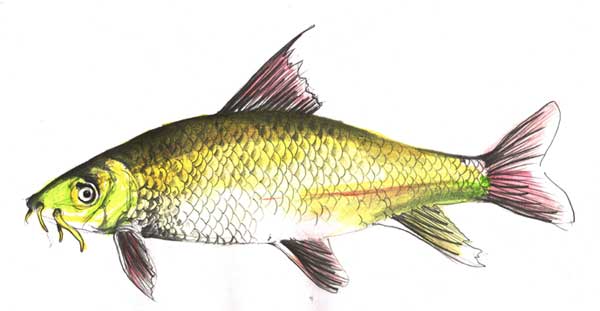
Barbel (Barbus barbus)
Current record: 21lb 2oz
Water: River Rother, Fittleworth, Sussex
The barbel, scientifically known as Barbus barbus, is a freshwater fish species native to various rivers and streams across Europe and Western Asia. Its distinctive features include four barbels, or whisker-like sensory organs, around its mouth, which it uses to locate food in murky waters. These barbels give the fish its name and play a crucial role in its feeding behavior.
Barbels are primarily bottom-dwellers, preferring slow-flowing or still waters with gravel or rocky substrates. They are often found in rivers, lakes, and ponds, where they can thrive in a variety of environmental conditions. The species is well-adapted to different habitats, displaying a remarkable ability to adjust to changes in water quality and temperature.
In terms of appearance, barbels typically have a streamlined body with shades of brown or olive, blending in with their surroundings. They can grow to impressive sizes, with some individuals reaching lengths of up to three feet. The barbel is a prized catch among anglers, known for its strength and challenging nature when hooked.
These fish are omnivorous, with their diet consisting of a variety of aquatic invertebrates, small fish, and plant matter. Their feeding habits contribute to the ecological balance of their habitats by regulating the populations of smaller aquatic organisms. Additionally, barbels are known for their resilience, adapting to changes in their environment caused by human activities and climate fluctuations.
Conservation efforts are essential to protect the barbel and its habitats, as they face threats from pollution, habitat degradation, and overfishing. Sustainable management practices, habitat restoration, and awareness campaigns are crucial for ensuring the continued survival of this fascinating and ecologically significant fish species.
Almost all of the small freshwater fish in the genus Barbus are referred to as barbel. They are typically found in slow-moving waters with a stony or gravelly bottom and high levels of dissolved oxygen. A typical mature barbel can be between 25 and 100 cm long and weigh 200 g to 10 kg, however 200 g is more typical. Babies range in weight from 100 to 150 g.
Fish like barbel are energetic and frequently cover large distances in a short amount of time. A person may move between 26 and 139 metres per day on average, and they can travel between 16 and 68 kilometres in a year. Although they may do so if they are in deeper water, close to bankside protection, or near underwater impediments, adults typically feed at night. They are especially well suited for eating benthic species, such as crustaceans, insect larvae, and mollusks, which they dig out of the gravel and stones of the riverbed with their underslung mouths. As the fish grow from fry to juveniles to adults, their diets alter. Young fish have a special need for the diatoms that cover rocks and the larvae of non-biting midges (Chironomidae).